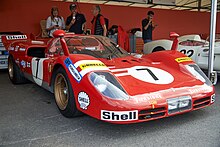 Ferrari 512 S | |
| Category | Group 5 sports car |
|---|---|
| Constructor | Ferrari |
| Technical specifications[1] | |
| Chassis | Steel tube space frame with riveted aluminium panels |
| Suspension (front) | Double wishbone, outboard coil spring/Koni damper, anti-roll bar |
| Suspension (rear) | Single top-link, reversed lower wishbone, twin radius arms, outboard coil spring/Koni damper, anti-roll bar |
| Axle track | 1,518 mm (59.8 in) front 1,511 mm (59.5 in) rear |
| Wheelbase | 2,400 mm (94.5 in) |
| Engine | Ferrari 4,993.53 cc (304.7 cu in) DOHC, 48-valve, 60° V12, naturally-aspirated, mid-mounted |
| Transmission | Ferrari 5-speed manual |
| Power | 404 kW (550 hp) @ 8500 rpm (512 S),[2] 449 kW (610 hp) @ 9000 rpm (512 M)[3] |
| Weight | 815–840 kg (1,796.8–1,851.9 lb) |
| Brakes | Girling disc brakes |
| Tyres | 90-24-15 front 14.5-26.2-15 rear |
| Clutch | Borg & Beck dry twin-plate |
| Competition history | |
| Notable entrants |
|
| Debut | 1970 24 Hours of Daytona |
| First win | 1970 12 Hours of Sebring |
Ferrari 512 S was a sports prototype car produced by Italian manufacturer Ferrari from 1969 to 1970. As it name suggests, the car had a 5.0L V12 engine. A total 25 units were built.
The car entered in the 1970 International Championship for Makes[4][5] by the factory Scuderia Ferrari and private teams. Later that year, modified versions resembling their main competitor, the Porsche 917, were called Ferrari 512 M (for modificata). In the 1971 International Championship for Makes, the factory focused on the new Ferrari 312 PB and abandoned the 512 which was only entered by privateers. From 1972 onwards, the 512 (as the 917) was withdrawn from the world championship following a change in the regulations; some 512s in private hands went on to compete in the CanAm and Interserie races.
- ^ "Il ritratto parallelo: Ferrari 512/Porsche 917" [Side by side portrait: Ferrari 512/Porsche 917]. Autosprint Anno 1970, Supplement to Autosprint (in Italian). X (51–52): 96. 21 December 1970.
- ^ "Ferrari 512 S (1970) - Ferrari.com". www.ferrari.com. Retrieved 1 April 2023.
- ^ "Ferrari 512 M (1970) - Ferrari.com". www.ferrari.com. Retrieved 1 April 2023.
- ^ "World Championship 1970". wspr-racing.com. Retrieved 27 August 2011.
- ^ "1970 International Championship for Makes points table". www.wspr-racing.com. Retrieved 28 February 2011.
